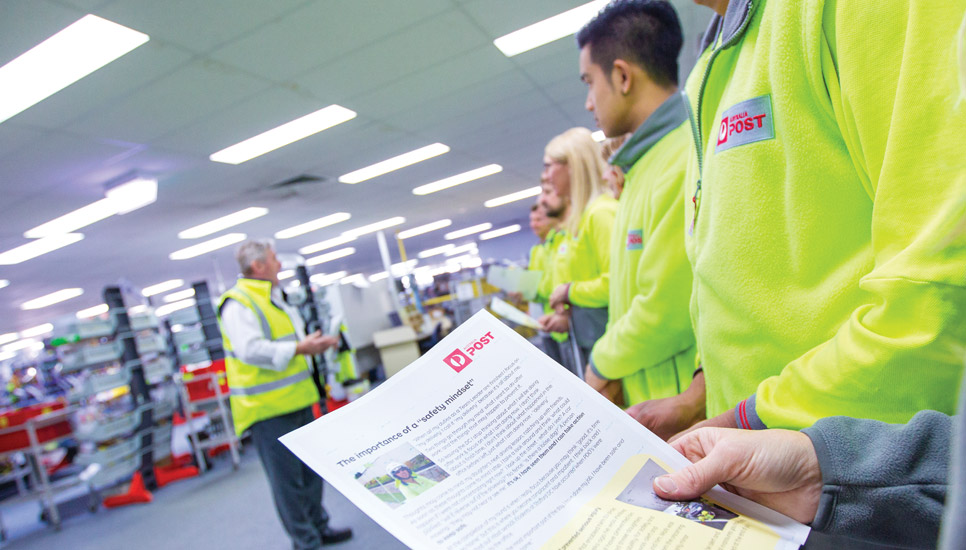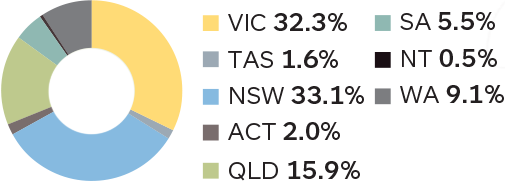Fostering an inclusive, engaged and capable workforce that operates safely to effectively support our customers.
Highlights
- Establishing the Post People 1st initiative, giving our employees priority when it comes to job opportunities, and skills and career development
- Launching our Workforce Conversations portal to engage our employees in two-way conversations about the future of our business
- Underpinning our commitment to Aboriginal and Torres Strait Islanders through our new Reconciliation Action Plan
Challenges
- Continuing to evolve our safety culture from one of compliance to personal accountability
- Maintaining a productive and harmonious industrial relations environment amid major business change
Outlook
- Extending communications channel access to all employees, including those working in non-corporate roles and on extended leave
- Continuing to engage our people in the need for ongoing changes to our business
Australia Post's diverse and capable workforce achieved a great deal during the year, supporting our transition into a modern postal and parcel business that meets the contemporary needs of the Australian community.
As our business model shifts to delivering enhanced services for our customers and operating a leaner corporate centre, our focus was on communicating openly and maximising the future employment prospects of our people.
This year's safety focus was on increasing personal accountability for safety, encouraging a culture where everyone takes responsibility for identifying potential safety exposures, then takes action to reduce the risk to themselves and others.
Strengthening our safety culture
We are constantly striving towards zero injuries and zero tolerance of unsafe acts in our workplaces. With most of our workforce based at postal facilities or out on the roads, we continued to focus our safety initiatives on addressing incidents associated with manual handling, load-shifting operations and use of motorcycles.
Key initiatives introduced this year include:
- refreshing our enterprise Health and Safety Strategy, defining five priorities that will underpin our plan to further improve our safety culture and performance
- continuing to strengthen the state-based Safety Coalitions that we introduced last year. Comprising Health and Safety Representatives and Safety Champions at all levels of the business, each Coalition now has accountability for tackling a major national safety risk – allowing the people who are closest to our workplace safety hazards to have a say in the solutions
- introducing Safety Moments and Safety Huddles to facilitate workplace conversations about safety. As the first item of meetings attended by senior managers nationally, Safety Moments provide an opportunity to relay a personal and relevant safety story. Daily Team Safety Huddles provide dedicated time for our operational teams to hold interactive discussions about safety and exposure during every shift
- holding our third annual Enterprise Safety Time campaign in October to coincide with Safe Work Australia month. More than 11,660 employees took part in 877 workshop discussions, with managers actively role modelling appropriate safety behaviours. A DVD was produced highlighting potential exposures in our operational and retail areas to stimulate employee discussion
- signing a new Occupational Health and Safety Agreement in December. The new agreement provides greater compliance, clarity and consistency in the way safety processes are undertaken and Health and Safety Representatives are elected.
Managing safety across our fleet
With 12,400 vehicles across the Australia Post Group (APG) fleet, we recognise the importance of driver health in preventing accidents, injuries and fatigue on the road. We support all our drivers and employees by:
- establishing clear policies related to shift duration, rest breaks and rest facilities
- ensuring that motorbikes and vehicles meet or exceed industry and safety standards
- providing training, education and resources related to driver health and safety on the roads.
Our shift regulations for long-haul drivers are in line with our work/rest requirements and our participation in specific accreditation schemes. We are accredited in Advanced Fatigue Management (AFM) and Basic Fatigue Management (BFM); however, we only roster our drivers to a maximum of 12 hours, in line with the standard hours requirement. To ensure the safety of our drivers and compliance with these regulations, trucks are fitted with telematics devices that record continuous driving hours.
Although there were marked improvements in our safety performance this year, tragically we lost one StarTrack employee in a heavy vehicle accident in July 2013. The loss of this valued team member was a reminder for all our employees of the constant vigilance required to protect the health and wellbeing of our people.
Improving our safety performance
This year saw a continued decline in the number of workplace injuries, demonstrating the sustained benefits of our Safety Now strategy.
Our All Occupational Injury Frequency Rate decreased to 22.8 from 25.6, a 10.9 per cent reduction. Our incident frequency rate also saw a 15.8 per cent reduction with 1.6 incidents per 100 full-time employees (down from 1.9 last year). Our Lost Time Injury Frequency Rate (LTIFR) reduced to 8.0 (down from 8.2 last year), a 2.4 per cent reduction.
|
Safety performance |
2011–12 |
2012–13 |
2013–14 |
|
Lost Time Injury Frequency Rate: Where next shift could not be worked due to injury/occupational disease (i.e. lost time, per million hours worked) |
11.5 |
8.2 |
8.0 |
|
Incident frequency rate: Incidents per 100 FTEs |
2.5 |
1.9 |
1.6 |
|
Injury rate: Incidents involving an injury per 200,000 hours worked |
2.8 |
3.9 |
3.4 |
|
Occupational disease rate: Incidents involving |
2.0 |
1.2 |
1.2 |
|
Fatalities (number)1 |
0 |
2
|
0 |
|
Fatality rate (per million km) |
0 |
0.0095 |
0 |
1 Does not include the single fatality at StarTrack mentioned above.

Leading the shift in our safety culture
This year we began implementing our Safety Leadership program across our operations network, following a successful pilot at four facilities. This contributed to a 50 per cent reduction in injuries across these sites over the five months following implementation.
Safety Leadership is designed to give leaders the skills to involve and influence their employees to create safe conditions and proactively reduce exposure to workplace hazards.
The current rollout focuses on 22 sites that represent the breadth of functions performed across our network.
Engaging our people
As our business evolves, it's important that we understand our people and provide avenues for them to discuss topics that they care about. We launched our Workforce Conversation portal in April 2014, an online channel for our people to receive important organisational updates, discuss their ideas and ask questions.
In May 2014 we invited our people to complete our annual say2action employee engagement survey. We achieved an 80 per cent response rate, representing the views of nearly 30,000 employees – a record number.
This year we conducted a more detailed survey, and as a result, received two scores.
Our overall employee engagement score was 74 per cent. This score helps us to look back and make a direct comparison to previous years' engagement scores. While this is a 4 percentage point drop from last year's record result, it is a highly positive score during a time of significant business transformation and reform. Since the commencement of Future Ready, overall engagement has increased by 5 percentage points (see graph ).
Our Net Engagement score was 56 per cent. This is Australia Post's new measure, which uses different methodology to provide more in-depth information on how our people feel about working at Australia Post. It examines our employees' engagement in greater detail and allows us to focus on the things that matter most during our transition. This is just one percentage point lower than the average employee engagement figure for Australian and New Zealand organisations, according to 2014 Aon Hewitt survey data.
Developing capability for tomorrow
In September 2013 we launched Post People 1st – an initiative that aims to maximise opportunities for our people by increasing the visibility of job vacancies, access to education and training, and career support and information.
Since the program's commencement, 2,705 Australia Post employees have moved jobs.
We continued to invest in initiatives that built employability, accessibility and capability through greater computer access for many of our operational employees. In total, 2,830 employees accessed a range of courses including career management, building resilience to change, English language and literacy skills, computer skills, sales and service training, and supervisor development.
Fostering future leaders
We continued to implement our Future Leaders strategy in 2013–14. As part of our Peak Alumni program, more than 100 senior leaders participated in Coaching Skills for Leaders. This three-hour workshop equipped participants with the GROW (Goal, Reality, Options, Wrap-up) coaching framework to enable high-impact conversations about performance, development and talent.
This year our Leadership Essentials program, which assists managers to understand the link between day-to-day leadership and business success, reached around 130 leaders over the course of the year.
We also strengthened the leadership capability of more than 300 of our frontline managers through our Supervisor Development program.
Embracing diversity and inclusion
This year Australia Post continued to develop and deliver a range of diversity programs and initiatives focused on building and leveraging a workforce that truly reflects the customers and communities we serve. We track our performance against four focus areas: Aboriginal and Torres Strait Islanders, gender, people with a disability, and culturally and linguistically diverse (CALD) people. For more information, access our 2014 Australia Post Diversity and Inclusion Annual Report at auspost.com.au/publications
Aboriginal and Torres Strait Islanders
Our Aboriginal and Torres Strait Islander employees represent 1.5 per cent of our workforce. Our goal is to increase this to 2.5 per cent of our total workforce by July 2017, reflecting the representation of Aboriginal and Torres Strait Islanders in the national population.
Our Reconciliation journey
During National Reconciliation Week in May 2014, we launched our third Reconciliation Action Plan (RAP). The plan commits to a series of actions in relation to building relationships, enhancing respect and improving opportunities for Aboriginal and Torres Strait Islanders.
This year also marked 25 years of having a formal commitment to providing employment opportunities and support to Aboriginal and Torres Strait Islander people and communities.
Australia Post's Reconciliation Action Plan can be accessed online at auspost.com.au
Gender equity
Our female leaders now make up 36.2 per cent of management roles (up from 35.9 per cent in 2013) and 34.1 per cent of executive positions (up from 33.3 per cent in 2013). In 2013–14 we continued to build our female talent pipeline through a range of programs:
- mymentor: a self-paced personal and career development program offered to our award-level female employees. The 2014 intake was our largest ever, attracting 476 participants. This year also marked the largest intake of mentors with 76 of our leaders (both men and women) taking on a mentoring role. Since the program's launch, over 1,200 of our female workforce have completed the mymentor program.
- Xplore: a leadership and career development program for our female managers. From July to December 2013, 37 women participated in the program. By the end of the financial year the retention rate of this future senior leadership talent pool was 97.3 per cent. Furthermore, 21.6 per cent of participants had been promoted to more senior positions.
- TenProgram: this program matched 10 of our high-potential women with 10 of our Management Committee. Eight of the 10 participants in this year's TenProgram progressed into more senior or expanded roles by 30 June 2014.
- Horizon: a 12-month leadership development program for women moving into senior management and general manager positions. We launched the Horizon program in October 2013 with 17 participants.
Supporting people with a disability
In progressing our Accessibility Action Plan in 2013–14 we:
- launched the Real Stories Project – our national disability awareness campaign
- expanded our annual internship program to always include at least one university student with a disability
- worked with Lifestyle Solutions – one of our new national community partners – to expand their work-ready program for people with a disability (see Making a positive social contribution)
- achieved Web Content Accessibility Guidelines 2.0 Level AA criteria for our mobile website, well ahead of the Australian Government's December 2014 deadline.
Workplace flexibility and support
We offer our people a range of options to help them balance their work and personal commitments, including changes to hours, days and location of work, job share arrangements, and beneficial leave provisions such as purchased leave (48/52), ceremonial leave and leave without pay.
Our people's attendance rate this year was 94.2 per cent (down from 94.3 per cent last year) and 95.7 per cent of employees returned to employment with us from parental leave. Of those who returned to work in 2012–13 following parental leave, 79.6 per cent remain employed with us 12 months after their return.
Industrial relations
As at 30 June, 30,665 of our award employees were covered by the Australia Post Enterprise Agreement 2013, which outlines their pay and working conditions.
With the Fair Work Commission's enterprise award modernisation process under way, we applied to the Commission to update Australia Post's four enterprise awards, which represent the minimum safety net of employment conditions for employees. We are working with the unions through this process which we expect will be completed by October 2014. Australia Post supports the right of all employees to exercise freedom of association.
Ethical behaviour
Australia Post has clear policies and expectations for acceptable standards of workplace behaviour. These behavioural standards are outlined in the booklet Our ethics: the way we do things at Australia Post. New employees receive a copy of the booklet and training at induction and we regularly reinforce our policies, which aim to prevent anti-social behaviour.
This year, most of workplace complaints relating to harassment and discrimination were managed locally, with 50 complaints escalated to our Workplace Relations and Policy team for investigation. Of these, 16 were substantiated, five were withdrawn and eight are still being investigated. We take appropriate remedial action to address breaches by employees, including training, counselling and disciplinary measures.

In 2013 we successfully negotiated the first back-to-back Enterprise Agreement in our history, which came into effect on 29 July. Australia Post won an Australian Human Resources Institute Award in December for our industrial relations strategy for the agreement.












